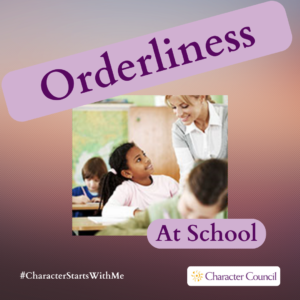
Orderliness In School
vs. confusion
Organizing my thoughts and surroundings for greater achievement
From Confusion to Orderliness
In a recent meeting of the Character Council, a new team member who is a mental health professional cautioned us about the use of our opposite quality. A student who is “low” on the performance scale for a particular quality (for example, Orderliness) may not be there due to a lack of character. There could be past or current trauma that is influencing their brain, or they could have a disorder or condition (for example, ADHD) that makes mastering a quality difficult.
All of us are on our own character journey, toting the emotional baggage we have accumulated. It’s essential to promote incremental achievements in improving character by setting small goals. Look for small negative behaviors to correct or positive behaviors to capitalize on. Use Resilience and Determination to keep trying. Celebrate small victories and use Patience to know these small victories will add up over time.
This month, when you see someone who lacks mastery in ANY of the character qualities, take some time to get to know their whys and help them create the scaffolding they need for personal growth.
The Links below will take you to Resources you can use in the classroom or in homeschool
to teach the Character Quality of Orderliness.
Need to build community in your classroom? Try these team building activities!
Good Graffiti
Each person starts with a sheet of drawing paper and crayons, colored pencils, or markers. The object of the activity is for each person to draw graffiti. Explain that graffiti is drawn on public buildings, trains, bathroom stalls, etc. by individuals who want to...
Our other Pillars have resources that can be used in an educational setting or for education professionals.
Visit Orderliness in Business>>
Teambuilding
Power Up with Character
Interview Questions
Adult Business Books
Visit Orderliness in the Community>>
Quotes
Character All Month Calendar
Related Qualities
Character Holiday Activities
Family Activity (with a printable for sending home to parents)
Visit Orderliness in Faith>>
Christian Family Activity
Bible Verses
Christian Poster
Prayer and Reflections
Archived Resources
